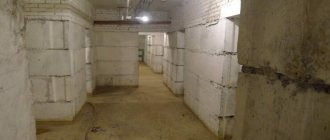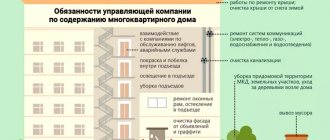Home inspection rules
Only a professional can evaluate the quality of construction. Moreover, you don’t have to look for it using familiar or free advertisements in the newspaper, since today there are entire companies engaged in construction expertise. Specialists will determine all the most important characteristics of the structure, for example, thermal conductivity and load-bearing capacity of walls, floors and foundations, moisture content of materials, the presence of hidden cracks and other defects, the efficiency of the engineering equipment used, etc. and so on.
As a result, you will receive a conclusion about the real condition of the object and an estimate of the costs of “bringing it to fruition.” This conclusion can be used in the process of bargaining with the owner of the house.
Calling a specialist will cost you quite a large sum. However, when buying a home worth several millions, skimping on checking the quality of what you are purchasing is simply short-sighted. However, there is a high probability that, after reading the expert opinion, you will decide not to purchase this property. This means that in the future we will have to call in more and more experts, for other objects.
Do you want to save tens of thousands of rubles? You can draw preliminary conclusions about the suitability of a house for habitation on your own. The most logical sequence of actions is quite simple. You, guided by our recommendations, inspect the house you are interested in (most likely not just one, but several) and only if you could not find any serious deficiencies and you are satisfied with everything, engage an expert for a professional assessment of the property.
1. It is better to view the house in the spring, during the period of active snow melting and increased soil moisture. Many people make the mistake of going for an inspection in the winter. This, of course, has its advantages, in particular, you can make sure that the heating system is functioning normally. But at the same time, in winter it is more difficult to assess the general condition of the house. Snow will hide from your view the crumbling foundation of the house and the cracked slate on the roof. You won’t even notice the dump in the far part of the yard. In the spring, all these flaws will be exposed, and melting snow and groundwater will immediately reveal the weak points of the structure.
2. Many people have an extremely negative attitude towards any used items, categorically refusing to “wear” for someone. But when choosing a home, it is better for them to reconsider their views. Preference should be given to houses in which people have lived for some time. The fact is that in the vast majority of cases, construction “for oneself” and “for sale” are two different levels of quality. If the owner of the house lived in it, this can serve as some guarantee of quality.
3. You should not hope that the owner of the house will honestly tell you about the existing shortcomings of his home, because he is interested in selling it quickly and profitably. You have to get to the bottom of the truth yourself. For example, a heart-to-heart conversation with neighbors will be very useful. They saw how the house was built and what is under the finishing, and, being uninterested persons, they can tell a lot of interesting things that the owner would prefer to keep silent about or deliberately hide.
4. It is necessary to evaluate not only the house itself, but also its location and the area adjacent to it. Is there excess moisture in the area? Is the house hidden from the sun's rays by trees or neighboring buildings? How convenient are the entrances? Are there high-voltage power lines or industrial facilities nearby?
5. While inspecting the house, write down any questions you have so you don’t forget to ask them to a specialist. Take photographs of places that are questionable from your point of view.
Of course, a significant part of the identified defects can be eliminated, but this will require additional financial investments from you, and therefore may become the basis for revising the final price.
What amount should be indicated in the house purchase and sale agreement?
Starting from 2021, you do not have to pay 13% personal income tax on housing sales transactions if it was your only home and you owned it for 3 years or more. Previously, only those who owned housing for at least 5 years could receive personal income tax benefits. Therefore, an owner who has owned a house for less than 3 years will most likely offer to indicate in the contract an amount of up to 1 million rubles. You have the right to refuse, especially since starting from 2021 the tax is calculated from 70% of the cadastral value of the property if the purchase and sale agreement specifies an amount less.
If the amount is full, and the house has been owned for less than 5 years, then you will have to compensate the seller 13% of the amount over 1 million rubles specified in the contract, which is not economically feasible, since you are giving the money now, and will return it within a few years in installments and only if you have not returned income tax before. If the amount in the contract is more than 70% of the cadastral value of the house, then 13% of the tax will be calculated from it.
The higher the amount in the agreement, the greater the tax deduction you will get back, and in the event of a form majeure or termination of the transaction, you will be returned only the amount specified in the agreement.
How to get a tax deduction when buying a house
Getting to know the layout
A house is not just square meters. Comfort depends not so much on the total area, but on the correct layout of the living space. What to look for when buying a home? What points are especially important?
A comfortable home can be called one in which it has been possible to achieve the right balance between the feeling of spaciousness and privacy. It’s good when the daytime premises - living room, hall, dining room - smoothly “flow” into each other: this will create a feeling of freedom and spaciousness and save you from the need to constantly open doors when moving around the house.
At the same time, it is very important that each family member has the opportunity to be alone if they wish. This, at a minimum, dictates the need to have a sufficient number of bedrooms in the house. It is not necessary that they be large: on the contrary, in a small room it is easier to create the feeling of coziness that is so necessary for relaxation. It is desirable that the house have as few narrow, long, dark corridors as possible.
Don’t forget about places to store household belongings – closets, closets, closets. Otherwise, while moving around the house, you will constantly come across clothes that are inappropriate for the season, children's sleds, pickle jars... you never know what else you want to hide for the time being from the eyes of yours and others. Since many communications of a private house are, as a rule, autonomous, it is necessary to provide a technical room. It should be taken into account that storerooms and technical rooms do not require full heating, which allows you to significantly save energy.
Be sure to pay attention to the stairs connecting the floors. Of course, you want it not to “eat up” too much useful space, but we should not forget that in the event of a fire this will be the main escape route from the second floor. From this point of view, it is very desirable that the stairs are not too narrow and steep. In addition, the magnitude of the risk of serious injury in the event of an accidental fall directly depends on the steepness of the staircase and the presence of a reliable guardrail.
How comfortable you will be living in your new home largely depends on the degree of illumination. There should be a lot of natural light in living spaces. It is clear that sunlight enters the home through windows, which means there should be quite a lot of them. However, you shouldn’t be too zealous either, because an overabundance of windows is one of the reasons for a decrease in the energy efficiency of a building.
When determining the most optimal number of windows, they proceed from the value found experimentally: the ratio of window area to floor area should be about 1:8.
Since we're talking about windows, it's worth saying a few words about the so-called houses with second light. These are buildings in which part of the interfloor ceiling is missing, and a large panoramic window is located on the entire wall of the premises located in this place (usually a living room or hall) with twice the height of the ceilings.
Undoubtedly, this looks impressive, but in practice it turns out to be not very rational: such a house has a larger heated volume and a smaller usable area. And, of course, an indispensable condition for such a house is a beautiful view from the window, otherwise there is no need to create such a view.
And in conclusion, let’s mention the garage found in any modern country house. Very often, part of the first floor is allocated for a garage. This is undoubtedly convenient: you can go down to your “iron horse” directly from home, without having time to freeze in the winter cold or get your shoes dirty with mud in the autumn bad weather.
However, this approach to planning also has its pitfalls. A garage built into the house requires good ventilation, otherwise the smell of gasoline and exhaust gases will be felt in the living spaces (it’s not for nothing that regulations prohibit placing bedrooms above the garage). If the garage is attached to the house, and even more so is located at some distance from it, problems with deteriorating air quality do not arise.
Checking the roof of a house
Very often, the attic of a house turns into a dump of unnecessary things - the owners leave its arrangement for later, finding many other, more important things to do. It is unlikely that you have a great desire to wander among boxes covered with a thick layer of dust, old suitcases, remnants of building materials and other belongings. However, it is necessary to go up to the attic.
It is from the attic that you can judge the condition of the roof. Ideally, if its inspection coincides with rainy weather - all defects will become clearly visible. But even if you are “unlucky” with the weather, you just need to carefully look around. Traces of leaks, mold or mildew indicate that the roofing work was carried out in bad faith, with a gross violation of technology, as a result of which the roof leaks. Such a house will not provide reliable protection from bad weather - refuse to buy it or prepare for considerable repair costs.
Be sure to pay attention to whether the drainage system is installed correctly. Its shortcomings can be identified by smudges on the outer surfaces of the walls, as well as by grooves washed out by water on the ground. At first glance, this seems like an insignificant detail, but improper drainage of water during rain can eventually lead to the destruction of the foundation and walls of the building.
How to draw up a house purchase and sale agreement correctly
The purchase and sale of a house can only be completed under an agreement with its subsequent registration in RosReestr - this minimizes the risk of being deceived by one of the parties. When drawing up a contract, please pay attention to the following:
- The purchase and sale agreement is drawn up in 4 copies (1 to the seller, 1 to the buyer, 1 remains in the MFC, 1 in RosReestr;
- Sign the contract on every page;
- Record the transaction amount in words and figures in the document;
- Describe in detail: when the money will be transferred, in what currency and what will happen if the money is not received on time;
- Add a description of the responsibilities of both the seller and the buyer;
- Draw up a detailed agreement: when the house will be abandoned and what property will be transferred along with the house to the new owner.
Preparation and payment of purchase and sale agreements are the responsibility of the seller. As a last resort, agree to pay 50/50.
Quality of construction of external walls
Wondering if your new home can serve as your fortress? Then carefully inspect the outer walls for cracks. There are many reasons for the appearance of cracks in the supporting structure: improper shrinkage of the house, the absence of monolithic reinforced concrete belts in the case of aerated concrete walls, etc. Even if you do not notice the cracks themselves, freshly plastered sections of the walls may indicate their presence. However, plastering is only a temporary solution to the problem, or rather, even an attempt to create the appearance of well-being. It is highly likely that the crack will reappear very soon.
Of course, the home should not only be durable and reliable, but also warm. Brick walls, regardless of their thickness, must be insulated with mineral wool or expanded polystyrene.
Walls made of aerated concrete may not be insulated, but only if their thickness exceeds 400 mm. Otherwise, a layer of mineral wool is used. It is not recommended to use expanded polystyrene for insulating aerated concrete, since it has less vapor permeability than the wall material, which means the dew point will shift inward. Over time, this can lead to the formation of condensation and, as a consequence, the appearance of mold and mildew on the inner surface of the walls.
Often they try to pass off foam concrete as aerated concrete. They are somewhat similar in appearance, but the latter has higher thermal conductivity. Walls made of foam concrete must be insulated with mineral wool with a layer of at least 100 mm.
Ceramic blocks are very popular and at the same time deservedly popular - a material that looks like brick, but with increased hollowness, and therefore with very low thermal conductivity.
Sometimes the building design is combined: the first floor is built from heavy material (for example, brick or ceramic blocks), the second floor is made from light material (for example, aerated concrete). This approach is acceptable and even rational (but doing the opposite, as you probably guess, is impossible). If one floor is made from materials that differ greatly in density, expect uneven settlement of the foundation.
What to look for when buying a home
- Specify the date of construction and period of ownership of the house;
- Find out about the territory development plans;
- Check the material of the walls and roof, the presence of a basement, etc.;
- Personally check the availability of: water, gas, electricity, sewerage and the Internet;
- Ask to see receipts for rent for the summer and winter periods. This way you will avoid surprises when paying for housing and communal services, and at the same time check whether the seller has any debts to utility services;
- Switch the heating to winter mode and check the temperature of the radiators;
- Make sure that the buildings in the local area are legal (bathhouse, garage, etc.);
- Make sure there are no debts on property taxes;
- Chat with your future neighbors - you will live with them;
- Talk about the price only with the owner, or the one who makes the decision to sell;
- Avoid salespeople who rush into making a decision.
It is important to understand that the cost of a home is determined only by the standard of living around it, and not by the number of square meters. In other words: the richer your future neighbors, the more expensive your house.
Floors and ceilings of the house
To assess the quality of the floors, first look at the ceiling of the lower floor. Deflection of the ceiling is a bad sign. A possible reason for this may be the insufficient cross-sectional area of the beams. In this case, over time the situation will worsen, i.e. the amount of deflection will increase. Strengthening the ceiling is an extremely difficult and very expensive task.
Whatever material the floor is made of - reinforced concrete or wood, it must be even. Any floor covering - parquet, laminate, linoleum - wears out very quickly on a sloping and especially uneven floor. It’s not difficult to make sure the floors are even, just don’t forget to take a building level with you when inspecting the house.
Wooden floors should also be checked for instability - there should be no noticeable vibrations under dynamic loads. The standard allows floor deformation within 2 mm per meter of length. This means that if, after jumping on the floor, you notice only minor vibrations, this is normal. But if the floor bends under you even when you walk, refuse to buy such a house or get ready for its global reconstruction.
It is advisable to evaluate the sound permeability of the ceiling. The reasons for the good audibility of impact and airborne noise produced by the floor above may be insufficient thickness of the insulating layer, loose fit of the roll, and the absence of sound-permeable gaskets in the places where it rests. The defect is eliminated by re-laying the floor.
Procedure for purchasing a house with land
- Before the transaction, it is better to entrust the verification of documents for the house and land to a lawyer;
- After checking, leave a deposit to the seller and agree on the date and place of the transaction in the “My Documents” MFC;
- In the MFC building, take an electronic coupon and, while you wait in line, carefully read the purchase and sale agreement, pay the state fee for the transfer of rights and make copies of payment receipts;
- When it’s your turn, go to the registration desk to sign contracts and process the purchase and sale. You can carry out a simple transaction (without a mortgage or shares) yourself - the registrar will always advise you;
- After signing the contracts, in the presence of the registrar, the buyer pays the seller, or the parties go to the bank for a cashless payment;
- At the end, the registrar will issue a receipt of the original documents indicating the date of issue of the registered agreement on the transfer of ownership to the new owner (usually 14 days).
Please note that when selling a house, the buyer acquires the right to use the corresponding land plot under the same conditions as the seller of the property. This means that if the ownership of the house was registered in Rosreestr, then the new owner automatically becomes a tenant under the lease agreement on the same terms as the old tenant - this is called universal succession.
In other words, you can sell your house without transferring the lease on the land.
How to transfer money when buying real estate
The quality of the foundation and basement of the house
The quality of the foundation is a mystery hidden underground. But it is this structural element that determines the strength and reliability of the entire building. Indirect evidence that the foundation is done correctly can be the absence of cracks on the walls. A more accurate assessment of its reliability can only be made by specialists, who will need to open holes in several places along the wall, that is, select soil to expose the foundation.
Take the time to carefully examine the basement. It is great if the inspection of the house occurred during a period of active snow melting and groundwater rising to maximum levels - at this time the presence of problems will be clearly visible. But even if it so happens that you are looking for housing in another season, take a close look at the walls and especially the corners of the basement.
If you notice traces of past flooding, this means that the foundation construction technology was violated - the waterproofing was poorly done, there are problems with the drainage system and ventilation ducts. Regular flooding will lead to the appearance of a persistent smell of dampness and mold in the house, and over time, to the destruction of the foundation.
Home engineering systems
The quality of communication systems determines how comfortable your life will be in your new home. That is why due attention should be paid to checking their condition.
Of course, all equipment that ensures the functioning of the electrical system, water supply and heating systems must work, which you should verify in practice. In addition, ask the seller to show you contracts with service companies - refusal to provide these documents should raise doubts about the legality of the connection.
Electrical wiring and pipes are usually hidden under the finish. They are difficult to see and, if necessary, replace. Therefore, feel free to ask for wiring diagrams for water, heat, gas and electricity. The absence of this information will greatly complicate operation and possible repair work. Instructions for use and warranty cards for equipment involved in ensuring the operation of engineering systems will not be superfluous.
Water supply
When starting to inspect the water supply system, you first need to ask what source the water comes from. If the house has an autonomous water supply system, that is, water is taken from a well or borehole, we strongly recommend taking a water sample for analysis to determine the concentration of heavy metals and the presence of pathogenic microflora. If the examination shows that the water in this source is of poor quality, you will have to fork out money to install an expensive purification system.
Check the functionality of the entire system. Carefully inspect the pipes for leaks - the presence of microcracks in them can be judged, for example, by traces of rust in certain areas. Make sure that the section of the pipeline leading from the well to the house, that is, passing along the street, has good thermal insulation. Otherwise, in winter the pipes may burst as a result of the expansion of frozen water in them.
Sewerage
Assess the condition of the sewer system. To do this, it is enough to drain a large volume of water (for example, from a pre-filled bath). If the process drags on for a long time, there is reason to think about it. Carefully inspect the sewer pipes - accumulation of moisture on them may indicate a leak.
If the house is not connected to a central sewer system, you will also have to inspect the cesspool or septic tank. The size of the storage tank should be close to standard, and its walls should be made of concrete or lined with brick or stone. If the cesspool is almost completely full, this should alert you. A possible reason could be a poorly functioning or even completely absent drainage system.
Heating system
The quality of the heating system can be fully assessed only in the cold season. If, at the time of inspecting the house, it is a fine summer day outside, ask the owners to turn on the boiler and after half an hour check the temperature of the heating radiators. Make sure hot water is supplied to radiators in all rooms of the house. Check whether the pipes and radiators are leaking, and whether the latter are equipped with air bleed valves.
Be sure to take a look at the boiler itself. When near working equipment, you should not smell gas or see puddles or traces of rust.
Electrical system
Another important object of your attention should be the power supply system. Some homes still use aluminum wiring that does not meet current standards and does not meet modern needs. Of course, the wires are hidden in the walls, but it is not difficult to find out the material from which they are made - just, for example, remove the cover of one of the sockets.
If at the time of inspecting the house there are any household electrical appliances in it, take the opportunity to evaluate the quality of the electrical wiring. Ask the owners to turn on all available devices at the same time. If the network can withstand the load, then you will not have to choose between a working iron and an electric stove.
Ventilation
To create and maintain a healthy microclimate in the house (and therefore for comfortable living in it), the flow of fresh air is very important. Find out about the ventilation system in the house you decide to buy. Of course, natural ventilation, when the movement of air is determined only by the difference in air temperatures outside and indoors, is simple and cheap. But simple and cheap, as a rule, is not the most profitable and effective. A big plus for the house will be the presence of forced ventilation.
Be sure to inspect the vents to make sure they are not clogged. Remember that poor ventilation threatens your home with destructive dampness, and you with a constant feeling of unpleasant odors and stuffiness, and in especially advanced cases, even with health problems.
Windows and doors
The main requirement for windows is that they are large enough to provide good illumination. At the same time, they must also have excellent heat and sound insulation qualities. The latter also applies to doors. Slopes must be insulated not only from the inside, but also from the outside - do not forget to make sure of this.
Don't neglect to carefully inspect your windows. We won’t even mention cracks in glass, damaged profiles, non-functioning fittings - you will probably notice such blatant disgraces without difficulty. But there are also hidden defects - for example, fogging of the space between the glasses, which can only be noticed in the cold season. The presence of moisture inside the glass unit indicates a violation of its tightness. The only solution to this problem is to replace the double-glazed windows, which you, as the future owner of the house, are unlikely to need.
At this stage of the house inspection, a conclusion can be made about the correct shrinkage of the house and the absence of distortions in the structure. Warped door and window frames will help reveal existing problems. Both windows and doors should open and close easily with little force (indicating a tight fit to the frame). Jamming is unacceptable - it is the first sign of improper shrinkage and, as a consequence, tilting of the house.








